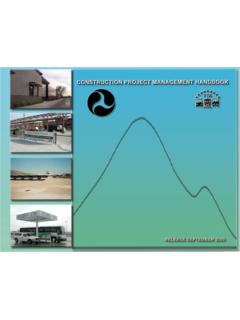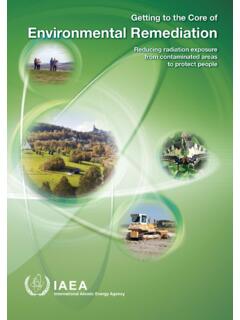Transcription of THE IMPORTANCE OF WATERSHED MANAGEMENT IN …
1 THE IMPORTANCE OF WATERSHED MANAGEMENTIN PROTECTING ONTARIO'S DRINKINGWATER SUPPLIESMARCH 20, 2001 PREPARED BY: CONSERVATION ONTARIOTABLE OF CONTENTSEXECUTIVE OF of the is WATERSHED MANAGEMENT ?.. is the Relationship of WATERSHED MANAGEMENT to Water Supply?.. s Tradition of WATERSHED DOES THE WATERSHED WORK?.. Issues in Water water and groundwater system capacity for Pathways and Treatment of of WATERSHED Processes on Water THE WATERSHED MANAGEMENT the a vision, goals and the information participatory the WATERSHED the Can WATERSHED MANAGEMENT Help Provide Adequate Clean Drinking Water?.. the big WATERSHED groundwater supplies (aquifers).
2 The regional groundwater the aquifer the aquifer environmental WATERSHED Surface Water surface water the surface water the surface water treatment and and WATERSHED Cost of WATERSHED for WATERSHED Enough Spent on WATERSHED MANAGEMENT ?.. Options for WATERSHED funding in direct AND ADMINISTRATIVE APPROACHES TO WATERSHED Trends in WATERSHED learned from international MANAGEMENT in Nova MANAGEMENT in AND 2-1: THE NATURAL WATER 2-2: HUMAN INTERVENTION IN THE WATER 3-1: THE WATERSHED MANAGEMENT 4-1: SOURCES OF REVENUES FOR WATERSHED 5-1: AN EVALUATION OF WATERSHED MANAGEMENT IN THE ONTARIO Decision Support Tools to Evaluate WATERSHED Quality Budget ToolsB.
3 Risk ManagementC. Federal and Provincial Water Quality Legislation (Tables)D. Information NeedsE. Case Studies of WATERSHED MANAGEMENT -United StatesF. WATERSHED MANAGEMENT in the United States, United Kingdom, France, Australia and New ZealandG. Walkerton Report Authors2 EXECUTIVE SUMMARYW atershed ManagementWater systems are life supporting, and a healthy water system is essential for a robust economy and agood quality of life . History has demonstrated that almost every action we take on the land shows up inthe water systems, for better or for worse. This paper is written from the perspective of local watershedmanagers, Ontario s Conservation Authorities.
4 It describes how integrated WATERSHED MANAGEMENT is animportant part of selecting and maintaining cost-effective water supply with minimal impact on the envi-ronment. While WATERSHED MANAGEMENT is broader in focus than drinking water supply, adequate, safe,and contaminant free water supply can be achieved while maintaining a healthy aquatic contrast to the simple, end of pipe solutions (treating the symptoms), this paper focuses on reducing oreliminating problems at their source. The integrated WATERSHED MANAGEMENT approach attempts to influ-ence how water is managed at each point of contact: by farmers, landowners, recreationalists, industry,land developers, municipalities, wastewater managers, and water supply managers.
5 Rather than focussingpiecemeal on individual problems, an integrated WATERSHED approach takes a holistic view, exploring thecause-effect relationships of human activities on natural functions and processes that extend across juris-dictional boundaries, and finding solutions that minimize negative environmental impacts. This is usuallydone through the implementation of a WATERSHED action plan that describes what each must do to ensure asafe and secure water supply and a healthy aquatic ecosystem. Therefore, the plan must be prepared incollaboration with those who must take action ( , interested parties, government, industry, and the gen-eral public).
6 RecommendationsBased on a review of WATERSHED MANAGEMENT in Ontario, the following recommendations focus on waysthat the province could improve upon current practices, and thus strengthen the role that WATERSHED man-agement plays in protecting the long-term security of drinking water The protection of drinking water sources should be recognized as a permanent and integralpart of a long-term, secure water supply protection represents the first layer in a multiple defence system for ensuring that cleanwater is available to all water users. Source protection is especially vital to water users, such asrural residents and businesses, whose geographic location and low water usage afford them fewalternative drinking water supply options and may limit the economic viability of employing end-of-pipe treatment measures.
7 Source protection programs are consistent with practices beingadopted by water supply agencies in other international The WATERSHED should be recognized as the viable unit for managing is the appropriate unit for the MANAGEMENT of both surface and groundwater resources. Vale-rie Gibbons in her report Managing the Environment: Executive Summary (Executive ResourceGroup, 2001) states that there should be a strategic shift in managing the environment towards aplace-based approach with boundaries that make environmental sense and facilitate a cross-media, cumulative approach (such as WATERSHED MANAGEMENT )". While groundwater aquiferssometimes extend beyond surface water drainage boundaries, the human activities and resultinginfluences occur and can be managed within a surface WATERSHED context.
8 Drinking water sourceprotection programs should be developed as part of an overall WATERSHED MANAGEMENT A provincial integrated water policy should be developed that: Recognizes the principles of WATERSHED MANAGEMENT and deals with all aspects of Province should expand its interests in WATERSHED MANAGEMENT beyond flood and erosioncontrol operations to achieve maintenance and enhancement of ground and surface water (bothquality and quantity) for all users. WATERSHED MANAGEMENT is based upon an understanding of thewatershed, its water cycle and its interrelationship with human activities. WATERSHED managementincludes identification, protection and enhancement of significant natural features including,headwaters, groundwater recharge and discharge areas, wetlands, vegetated stream buffers andforest areas, while considering historical and current human activities impacting the system.
9 Builds upon the conservation authority model to advance WATERSHED a resource that crosses jurisdictional boundaries while lending itself to so many different andconflicting uses, water defies simple division into federal, provincial or municipal of water supply and quality requires collaboration and co-ordination at a level whereprogress can be made through actions determined by long-term WATERSHED MANAGEMENT conservation authority model provides an opportunity to co-ordinate, focus and streamlinelocal delivery of water MANAGEMENT and protection actions. Current strengths need to be builtupon and the capacity of conservation authorities increased to provide a base level of watershedmanagement for the benefit of 90% of the provincial population.
10 Clarifies the role of the provincial government in water Province has the broadest jurisdiction over water and therefore has a leadership responsibilityin ensuring the best water MANAGEMENT for the citizens of Ontario. A provincial water policyshould specify the role of the Province in developing consistent standards, implementation proce-dures, regulations, and enforcement measures to ensure performance at the local level. It shouldalso recommit to the WATERSHED planning initiatives undertaken by the Ministry of Natural Re-sources and the Ministry of the Environment in order to provide guidance to local and regionalauthorities in planning appropriate future land use while at the same time, protecting water re-sources and the environment.






